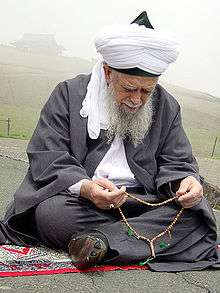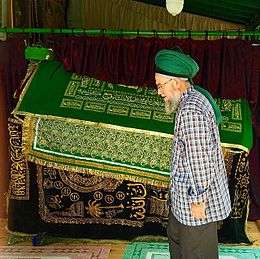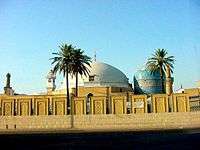Nazim Al-Haqqani
| Shaykh Nazim | |
|---|---|
 Nazim al-Haqqani, invoking the Tasbih (prayer). | |
| Born |
Mehmet Nazım Adil April 21, 1922 Larnaca, Cyprus |
| Died |
May 7, 2014 (aged 92) North Nicosia, Northern Cyprus |
| Occupation | Former leader of the Naqshbandi Haqqani Sufi Order |
| Religion | Sunni, Sufi Islam |
| Website | www.Saltanat.org [www.naqshbandi.org] |

Mehmet Nazim Adil (April 21, 1922 CE – May 7, 2014; Sha'ban 23, 1340 AH – Rajab 8, 1435 AH), commonly known as Shaykh Nazim, was a Turkish Cypriot Sufi Muslim sheykh and spiritual leader of the Naqshbandi tariqa.
Names
Shaykh Nazim was active in Turkish and Arabic language contexts. His name was therefore transliterated into English in various ways: Nazim Qibrisi (Turkish: Nazım Kıbrısi), indicating his homeland of Cyprus (Turkish: Kıbrıs), and Muhammad Nazim Adil al-Qubrusi al-Naqshbandiya Aliyya Sufi Order al-Naqshbandi (Arabic: محمد ناظم عادل القبرصي الحقاني النقشبندي). His name al-Haqqani is an honorific granted by his Sufi teacher Abdullah Fa'izi ad-Daghestani. He has no connection with the Islamic insurgent group known as the Haqqani network.
Early life
Shaykh Nazim was born in Larnaca, Cyprus, on April 21, 1922 CE (Sha'ban 23, 1340 AH). He traced his paternal lineage to the Islamic prophet, Muhammad, through the Sufi saint Abdul Qadir Jilani. He further traced his maternal line to Muhammad's companion Abu Bakr as-Siddiq – who has special significance in the Naqshbandi Sufi order (tariqa) – through the Sufi saint and poet Jalaluddin Rumi.[1] He was first exposed to Sufism as a young child by his paternal grandfather, who was a Sufi shaykh in the Qadiriyya order.
He moved to Istanbul, Turkey, in 1940 to study chemical engineering at Istanbul University. He would later state, "I felt no attraction to modern science; my heart was always drawn to the spiritual sciences."[1]
Studies in Sharia' and Sufism
In Turkey
In Istanbul, Shaykh Nazim studied Classical Arabic and Islamic Jurisprudence (fiqh) under Shaykh Jamal al-Din al-Alsuni (d. 1955 CE/1375 AH) and received ijaza these subjects from him. He was initiated in Naqshbandi Sufism by Shaykh Sulayman Arzarumi (d. 1948 CE/1368 AH), who eventually directed him to Damascus, Syria, to continue his studies. He left Istanbul and arrived in Syria in 1944.[1]
In Syria
In Syria, Shaykh Nazim continued his sharia studies in Aleppo, Hama, and Homs. In Homs, he studied at the madrasa adjoining the burial shrine and mosque of Muhammad's companion, Khalid ibn al-Walid. There, he received further ijazas in Hanafi jurisprudence (fiqh) from Shaykh Muhammad 'Ali' Ayoun al-Soud and Shaykh Abdul Jalil Murad. He also studied and received ijaza in hadith studies from the Muhaddith Shaykh Abdul Aziz ibn Muhammad Ali Ayoun al-Soud al-Hanafi.
Following the end of the unrest in the region due to World War II, Shaykh Nazim was able to enter Damascus in 1945. There, he met the Naqshbandi Sufi Shaykh Abdullah Fa'izi ad-Daghestani, and they exchanged the Sufi oath of mutual allegiance (bay'ah). He would consider Shaykh Abdullah as his primary spiritual director (murshid) until the latter's death in 1973.[1]
Islamic Missionary Activity
Shaykh Nazim returned to Cyprus and began Islamic missionary activity. Whilst there, he came into conflict with the Kemalist governing body of the Turkish community of the island. The government had enacted laws forbidding the public performance of the Islamic call to prayer (adhan) in its traditional Arabic form. Regardless, Shaykh Nazim continued to do so. The conflict was resolved with the coming to power of Adnan Menderes in Turkey, whose government chose a more tolerant approach to Islamic traditions.[1]
Shaykh Nazim took up residence in Damascus in 1952 to continue his studies with Shaykh Abdullah, though he continued to spend three months or more each year in his native Cyprus.[1] Shaykh Nazim would eventually become the Grand Mufti of Turkish Cyprus.
International mission
Following the death of Shaykh Abdullah Fa'izi ad-Daghestani in 1973, Shaykh Nazim was recognized as his successor to head the Sufi order by Shaykh Abdullah's small network of students. From 1974, he began to visit Western Europe, traveling every year to London, England, for the month of Ramadan. He would gain a large following of spiritual seekers from Western Europe and North America, many of whom converted to Islam after encountering his teaching.[2] From 1980, his lectures on Islam and Sufism were published in English and other European languages.[2]
Shaykh Nazim's transnational appeal was facilitated by his ability to speak English, Turkish, Arabic, and Greek.[2]
In 1991, Shaykh Nazim visited the United States for the first time at the invitation of his son-in-law and representative Shaykh Muhammad Hisham Kabbani. At that time, he made the first of four nationwide tours.
In 1997, Shaykh Nazim visited Daghestan, the childhood home of his primary Sufi shaykh, Shaykh Abdullah Fa'izi ad-Daghestani. He also made several visits to Uzbekistan where he made pilgrimage to the tomb of the eponymous founder of the Naqshbandi Order, Baha-ud-Din Naqshband Bukhari.[1]
In 1998, Shaykh Nazim was the guest of honor at the Second International Islamic Unity Conference, held in Washington, D.C. Later in the same year, he traveled to South Africa, visiting Cape Town, Johannesburg and Durban.
Notable Followers
Among Shaykh Nazim's Sufi Muslim students are the Sufi shaykhs Muhammad Hisham Kabbani, Muhammad Adnan Kabbani, Mehmet Adil, Bahauddin Adil, Gibril Haddad, and the late Raja Ashman Shah and Abdul Kerim Kibrisi. Among his other noteworthy students is also Sultan of Brunei Hassanal Bolkiah,.[3] Due to his influential teachings and leading spread of Sufism for the West, among public figures that derived inspiration from some of his teachings though notably vary in their own paths are people as diverse as author Stephen Suleyman Schwartz, the late author Hasan Lutfi Shushud and British teacher of spirituality John G. Bennett.[4][5][6]
Political Opinions
Shaykh Nazim was involved in the political realm as well. He had close ties with several notable politicians, notably the late president of Turkey, Turgut Ozal,[7] and the Turkish Cypriot leader, Rauf Denktaş.[3] Born just before the fall of the Ottoman Empire, he praised Ottoman history and civilization, contrasting its culture to its successor, the modern-day Republic of Turkey.[8]
Shaykh Nazim also repudiated terrorism as a key feature of his teachings.[6] He said:
Those who plant bombs and kill the innocent are not Muslims. A Muslim defends the faith by fighting face to face, not by cowardly means.[6]
To this end, Shaykh Nazim had expressed ardent support for George W Bush and Tony Blair's "War on Terror", to the extent of declaring them as achieving sainthood due to their efforts in "fighting tyrants and evil and devils".[6] Shaykh Nazim also most notably predicted that the regimes in the Middle East would be replaced by one ruling sultanate before the end of 2011. Shaykh Nazim also claimed that Prince Charles had "really embraced Sufism and Islam in his heart" and would forcibly dissolve the Parliament of the United Kingdom.[6]
Honors
Shaykh Bahauddin adil (Pingat Darjah Kebesaran DKA) from Sultan Azlan Shah of Perak in 2009.[9][10]
Recognition
In his later years, Shaykh Nazim was regularly recognized among the world's 50 most influential Muslims in the annual publication, The 500 Most Influential Muslims: he was ranked 49th, 49th, 48th, 45th, and 42nd in the 2009-2013 editions, respectively.[11]
Death

Shaykh Nazim had been receiving intensive care since April 17, 2014, when he was rushed from his home in Lefke to the Near East University Hospital in North Nicosia, Northern Cyprus, after suffering from respiratory problems. He died there on May 7, 2014, (8 Rajab 1435) aged 92.[7][12] His grave and burial shrine is located in Lefke, Cyprus, at his Sufi lodge and former home. Shaykh Nazim appointed his son, Shaykh Muhammad Mehmet Adil, as the leader of the Naqshbandi Aliyya.
Published works
- Qibrisi, Nazim. 1980. Mercy Oceans: The teachings of Maulana Abdullah al-Faizi ad-Daghestani. n.p.
- Daghistānī, ʻAbd Allāh al-Naqshbandī, and Nazim Haqqani. 1980. Mercy oceans: Winter lectures 1400 H. (1980 A. D.); Book two. Konya, Turkey: Sebat.
- al-Qubrusi, Nazim Adil. 1982. Mercy Oceans' Endless Horizons; Summer lectures from 1981. Konya, Turkei: Sebat Offset Pr.
- al-Qubrusi, Nazim Adil. 1983. Mercy Oceans' Pink Pearls. Konya, Turkei: Sebat Offset Pr.
- Haqqani, Nazim. 1984. Mercy oceans' divine sources: The discourses of our master Sheikh Nazim Al-Qubrusi (Imam ul-Haqqaniyyin). Konya, Turkey: Sebat.
- –––. 1985. Mercy oceans of the heart: the discourses of our master Sheikh Nazim Al-Qubrusi (Imam ul-Haqqaniyyin). [Turkey?]: [s.n.].
- al-Qubrusi, Nazim Adil. 1986. Mercy Oceans Rising Sun. Konya, Turkey: Sebat.
- Haqqani, Nazim. 1987. The secrets behind the secrets behind the secrets. Berlin: Duru.
- al-Qubrusi, Nazim Adil. Toward the Divine Presence: Book one, London Talks, Summer 1984. n.p.n.d.
- Haqqani, Nazim. 1987. Mercy oceans' lovestream: the discourses of our master Sheikh Nazim al-Qubrusi al-Haqqani delivered by the permission of his Grandsheikh Sheikh Abdullah Ad-Daghistani; Selected lectures Summer 1406 A. H. (1986 C. E.); London, Germany, Switzerland. Konya: Sebat.
- Haqqani, Nazim. 1987. Mercy oceans: Serendib edition; Transcript of lectures. Colombo: Council of Thareeqathun Naqshbandhia.
- Al-Qubrusi, Sheikh Nazim Adil. 1988. Mercy Oceans' Hidden Treasures, 2nd ed. Konya, Turkey: Sebat.
- Daghistānī, ʻAbd Allāh al-Naqshbandī, Nazim Haqqani. 1988. The Naqshbandi way: a guidebook for spiritual progress; The spiritual exercises of the Naqshbandi Sufi path according to the instructions of Sultan Ul-Awliya Sheikh Abdullah Ad-Daghistani. Konya, Turkey: Mercy Oceans publications.
- An-Naqshabandi, Sheikh Nazim Adil Al-Haqqani. 1989. Mercy Oceans Saphires from Serendib. Colombo, Sri Lanka: Arafat Publishing House.
- Naqshbandi, Muhammad Nazim Adil al-Haqqani. 1990. From Dunya to Maule: (from here to hereafter). İstanbul: Sebil Yayınevi.
- An-Naqshabandi, Sheikh Nazim Adil Al-Haqqani. 1990. Mercy Oceans' Emeralds of Eden: Lectures of a Sufi Grandsheikh. Colombo, Sri Lanka: Peacock Printers.
- –––. 1992. Natural medicines. London: Ta-Ha.
- Naqshbandi, Muhammad Nazim Adil al-Haqqani. 1994. Mystical secrets of the last days. Los Altos, CA: Haqqani Islamic Trust for New Muslims.
- Haqqani Naqshbandia, Sheikh Nazim al al-. 1994. Keys to paradise. London: Zero Productions.
- Naqshbandi, Muhammad Nazim Adil al-Haqqani. 1994. The divine kingdom. Los Altos, CA: Haqqani Islamic Trust for New Muslims.
- Haqqani, Sheik Nazim. 1995. Natural medicines: traditional Sufi healing methods. London: Zero Productions.
- al-Haqqani, Nazim. 1995. Power oceans of light. London: Zero Publications.
- Naqshbandi, Muhammad Nazim Adil al-Haqqani. 1995. When will peace come to earth?: Oh people, don't waste. London: Zero Productions.
- Haqqani, Nazim. 1996. Secret desires: talks given in 1996 in Germany and Great Britain by a sufi master of our time. London: Zero Productions.
- Naqshbandi, Muhammad Nazim Adil al-Haqqani. 1997. Defending truth: associations with a Sufi master of our time. London: Zero Productions.
- Nāẓim ʻAdl al-Ḥaqqānī, Muḥammad. 1997. Islam the freedom to serve: Suhbats, aphorisms, and stories. Bonndorf im Schwarzwald: Gorski und Spohr.
- al-Haqqani, Sheikh Nazim. 1998. Pure hearts. London: Zero Productions.
- Naqshbandi, Muhammad Nazim Adil al-Haqqani. 1998. Secret desires. London: Healing Hearts / Zero Productions.
- –––. 1998. Star from heaven: talks given in 1995 by a Sufi master of our time in England, Germany, Switzerland and Italy. London: Zero Productions.
- –––. 2002. In the mystic footsteps of saints. 2 vols. Fenton Mich: Naqshbandi Haqqani Sufi Order.
- Al-Haqqani, Shaykh Nazim Adil. 2002-2007. Liberating the soul: a guide for spiritual growth. 6 vols. [S.l.]: Islamic Supreme Council of America.
- Naqshbandi, Muhammad Nazim Adil al-Haqqani, and Muhammad Hisham Kabbani. 2004. Naqshbandi awrad of Mawlana Shaykh Muhammad Nazim Adil al-Haqqani. Fenton, MI: Islamic Supreme Council of America.
- Naqshbandi, Muhammad Nazim Adil al-Haqqani. 2006. The path to spiritual excellence. Fenton, MI: Islamic Supreme Council of America.
- Naqshbandi, Muhammad Nazim Adil al-Haqqani. 2007. Through the eye of the needle: Counsel for Spiritual Survival in the Last Days. Fenton, Mich: Institute for Spiritual & Cultural Advancement.
- Al-Haqqani, Mawlana Sheikh Nazim, and Hamidah Torres. 2008. Sufi spiritual practices for polishing the mirror in the heart. [Mar de Plata, Argentina]: SereSereS.
- Al-Haqqani, Mawlana Sheikh Nazim. 2008. Love sufi teachings and spiritual practices. Málaga: SereSereS.
- Naqshbandi, Muhammad Nazim Adil al-Haqqani. 2010. The Sufilive series. Fenton, MI: Institute for Spiritual and Cultural Advancement (ISCA).
- Naqshbandi, Muhammad Nazim Adil al-Haqqani, and Muhammad Hisham Kabbani. 2010. Spiritual discourses of Sultan al-Awliya Mawlana Shaykh Muhammad Nazim Adil Al-Haqqani. Fenton, MI: Institute for Spiritual and Cultural Advancement (ISCA).
- –––. 2010. Breaths from beyond the curtain: spiritual guidance of the Naqshbandi Sufi Masters. Fenton, Mich: Institute for Spiritual and Cultural Advancement.
References
- 1 2 3 4 5 6 7 'The Naqshbandi Sufi Way' by Hisham Kabbani. KAZI Publications, 1995. Biography
- 1 2 3 Böttcher, Annabelle (2006). "Religious Authority in Transnational Sufi Networks: Shaykh Nazim al-Qubrusi al-Haqqani al-Naqshbandi". In Krämer, Gudrun; Schmidte, Sabine. Speaking for Islam: Religious Authorities in Muslim Societies. Leiden: Brill. pp. 241–268. ISBN 900414949X. Retrieved November 24, 2014.
- 1 2 Sheikh Nazim Al-Haqqani
- ↑ Hasan Lutfi Shushud
- ↑ John G. Bennett
- 1 2 3 4 5 "Shaykh Muhammad Nazim al-Haqqani - obituary". Telegraph.co.uk. Retrieved 2015-12-13.
- 1 2 "Islamic scholar Shaykh Nazım dies at the age of 92".
- ↑ Nazim al-Haqqani, Magnificence. Saltanat: The Majesty and Magnificence of Islam, vol. 9, #8. December 2011.
- ↑ ASAL USUL ORANG MELAYU- menurut PARA ULAMA HAKIKAT -dan HERITAGE MELAYU BERIMAN (Malaysian)
- ↑ Maulana Sh Nazim Haqqani telah pulang kepangkuan Allah Ta'ala
- ↑ "The 500 Most Influential Muslims, 2009-2013". Retrieved 2014-11-23.
- ↑ "Cypriot leading figure of Islam's Sufi branch dies".
Further reading
- Ron Geaves, The Sufis of Britain: An Exploration of Muslim Identity (Cardiff Academic Press, Cardiff 2000), pp. 145 – 156
- Ludwig Schleßmann, Sufismus in Deutschland: Deutsche auf dem Weg des mystischen Islam (Bo¨hlau, Cologne 2003), pp. 43 –136
- Jørgen S. Nielsen, ‘Transnational Islam and the Integration of Islam in Europe’ in Stefano Allievi and Jørgen S Nielsen (eds), Muslim Networks and Transnational Communities in and across Europe (Brill, Leiden 2003) 28 –51.
- David Damrel, ‘Aspects of the Naqshbandi-Haqqani Order in America’ in Jamal Malik and John R. Hinnells (eds.), Sufism in the West (Routledge, Abingdon, 2006).
- Jørgen S. Nielsen, Mustafa Draper and Galina Yemelianova, ‘Transnational Sufism: The Haqqaniyya’ in Jamal Malik and John R. Hinnells (eds), Sufism in the West (Routledge, Abingdon 2006), pp. 103– 114.
- Simon Stjernholm, ‘A Translocal Sufi Movement: Developments among Naqshbandi-Haqqani in London’ in Catharina Raudvere and Leif Stenberg (eds), Sufism Today: Heritage and Tradition in the Global Community (I.B. Tauris, London 2009), pp. 83 – 101.
- Simon Stjernholm, Lovers of Muhammad: A Study of Naqshbandi-Haqqani Sufis in the Twenty-First Century (Lund University, Lund, 2011).
